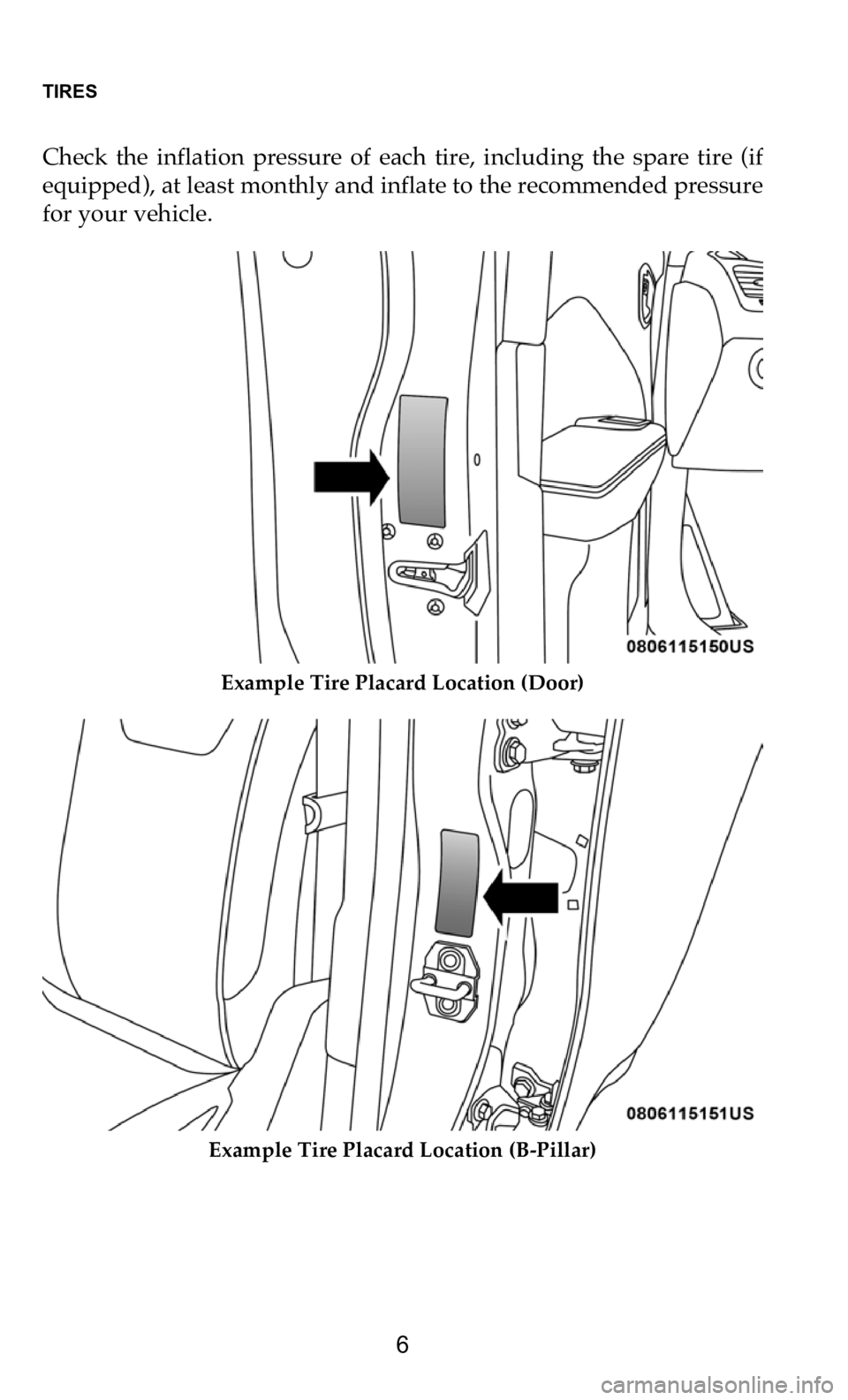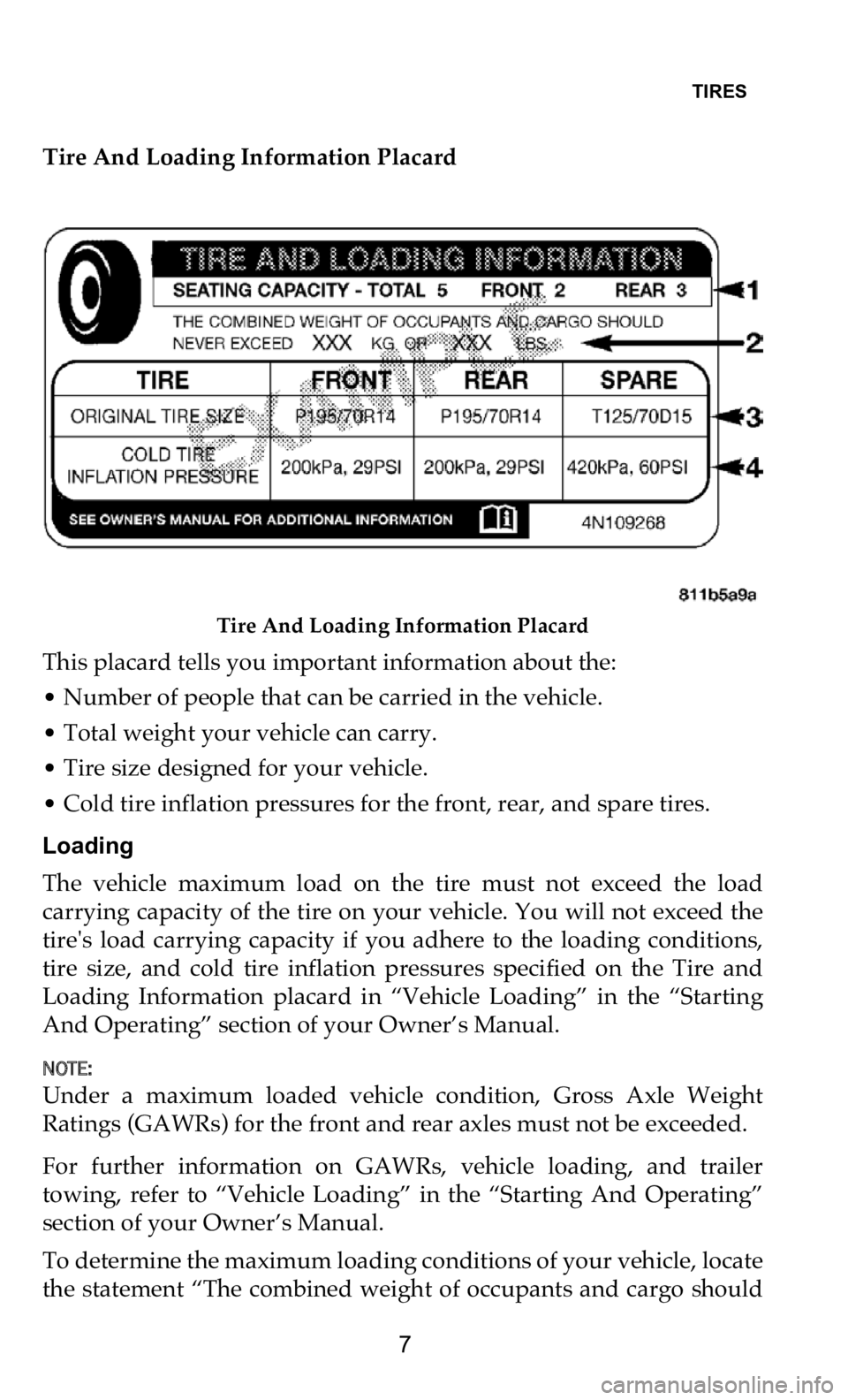flat tire DODGE DURANGO 2021 Vehicle Warranty
[x] Cancel search | Manufacturer: DODGE, Model Year: 2021, Model line: DURANGO, Model: DODGE DURANGO 2021Pages: 262, PDF Size: 10.42 MB
Page 5 of 262

TIRES
4
Tire Identification Number (TIN)
The TIN may be found on one or both sides of the tire; however, the
da
te code may only be on one side. Tires with white sidewalls will
have the full TIN, including the date code, located on the white
sidewall side of the tire. Look for the TIN on the outboard side of black
sidewall tires as mounted on the vehicle. If the TIN is not found on the
outboard side, then you will find it on the inboard side of the tire.
Load Identification:
Absence of the following load identification symbols on the sidewall of the tire
in dicates a Standard Load (SL) tire:
• XL
= Extra load (or reinforced) tire, or
•LL
= Light load tire or
•C, D, E, F, G
= Load range associated with the maximum load a tire can carry at a
specified pressure
Maximum Load –
Maximum load indicates the maximum load this tire is designed to
carry
Maximum Pressure –
Maximum pressure indicates the maximum permissible cold
tire inflation pressure for this tire
EXAMPLE:
DOT MA L9 ABCD 0301
DOT = Department of Transportation
•
This symbol certifies that the tire is in compliance with the US Department of Trans -
p
ortation tire safety standards and is approved for highway use
MA = Code representing the tire manufacturing location (two digits)
L
9 = Code representing the tire size (two digits)
A
BCD = Code used by the tire manufacturer (one to four digits)
0
3 = Number representing the week in which the tire was manufactured (two digits)
•
03
means the 3rd week
01 = Number representing the year in which the tire was manufactured (two digits)
•
01
means the year 2001
• Prior to July 2000, tire manufacturers were only required to have one number to
r
epresent the year in which the tire was manufactured. Example: 031 could repre -
sent the 3rd week of 1981 or 1991
EXAMPLE:
Page 6 of 262

TIRES
5
Tire Terminology And Definitions
Tire Loading And Tire Pressure
NOTE:
The proper cold tire inflation pressure is listed on the driver side
B-
pillar or the rear edge of the driver side door.
Term Definition
B-pillar The vehicle B-pillar is the structural member of the
bo
dy located behind the front door.
Cold Tire Inflation Pressure Cold tire inflation pressure is defined as the tire
pr
essure after the vehicle has not been driven for
at least three hours, or driven less than 1 mile
(1
.6 km) after sitting for a minimum of three hours.
In
flation pressure is measured in units of PSI
(pounds per square inch) or kPa (kilopascals).
Maximum Inflation Pressure The maximum inflation pressure is the maximum
pe
rmissible cold tire inflation pressure for this tire.
The maximum inflation pressure is molded into the
sidewall.
Recommended Cold Tire In
flation Pressure Vehicle manufacturer's recommended cold tire
in flation pressure as shown on the tire placard.
Tire Placard A label permanently attached to the vehicle
de
scribing the vehicle’s loading capacity, the
original equipment tire sizes and the
recommended cold tire inflation pressures.
Page 7 of 262

TIRES
6
Check the inflation pressure of each tire, including the spare tire (if
equipped), at least monthly and inflate to the recommended pressure
for your vehicle.
Example Tire Placard Location (Door)
Example Tire Placard Location (B-Pillar)
Page 8 of 262

TIRES
7
Tire And Loading Information Placard
Tire And Loading Information Placard
This placard tells you important information about the:
• Number of people that can be carried in the vehicle.
•
Total weight your vehicle can carry.
•
Tire size designed for your vehicle.
•
Cold tire inflation pressures for the front, rear, and spare tires.
L
oading
The vehicle maximum load on the tire must not exceed the load
ca
rrying capacity of the tire on your vehicle. You will not exceed the
tire's load carrying capacity if you adhere to the loading conditions,
tire size, and cold tire inflation pressures specified on the Tire and
Loading Information placard in “Vehicle Loading” in the “Starting
And Operating” section of your Owner’s Manual.
NOTE:
Under a maximum loaded vehicle condition, Gross Axle Weight
Ra
tings (GAWRs) for the front and rear axles must not be exceeded.
For further information on GAWRs, vehicle loading, and trailer
to
wing, refer to “Vehicle Loading” in the “Starting And Operating”
section of your Owner’s Manual.
To determine the maximum loading conditions of your vehicle, locate
th
e statement “The combined weight of occupants and cargo should
Page 11 of 262

TIRES
10
Tires — General Information
Tire Pressure
Proper tire inflation pressure is essential to the safe and satisfactory
op
eration of your vehicle. Four primary areas are affected by
improper tire pressure:
• Safety and Vehicle Stability
•
Economy
•
Tread Wear
•
Ride Comfort
S
afety
Both underinflation and overinflation affect the stability of the vehicle
a n
d can produce a feeling of sluggish response or over responsiveness
in the steering.
NOTE:
• Unequal tire pressures from side to side may cause erratic and
unpredictable steering response.
• Unequal tire pressure from side to side may cause the vehicle to drift
l
eft or right.
WARNING!
• Improperly inflated tires are dangerous and can cause collisions.
•
Underinflation increases tire flexing and can result in over -
h
eating and tire failure.
• Overinflation reduces a tire's ability to cushion shock. Objects
o
n the road and chuckholes can cause damage that result in tire
failure.
• Overinflated or underinflated tires can affect vehicle handling
a
nd can fail suddenly, resulting in loss of vehicle control.
• Unequal tire pressures can cause steering problems. You could
l
ose control of your vehicle.
• Unequal tire pressures from one side of the vehicle to the other
c
an cause the vehicle to drift to the right or left.
• Always drive with each tire inflated to the recommended cold
t
ire inflation pressure.
Page 12 of 262

TIRES
11
Fuel Economy
Underinflated tires will increase tire rolling resistance resulting in
hi
gher fuel consumption.
Tread Wear
Improper cold tire inflation pressures can cause abnormal wear
pa
tterns and reduced tread life, resulting in the need for earlier tire
replacement.
Ride Comfort And Vehicle Stability
Proper tire inflation contributes to a comfortable ride. Overinflation
pr
oduces a jarring and uncomfortable ride.
Tire Inflation Pressures
The proper cold tire inflation pressure is listed on the driver side
B-
pillar or rear edge of the driver side door.
At least once a month:
• Check and adjust tire pressure with a good quality pocket-type
p
ressure gauge. Do not make a visual judgement when determining
proper inflation. Tires may look properly inflated even when they
are under-inflated.
• Inspect tires for signs of tire wear or visible damage.
I
nflation pressures specified on the placard are always “cold tire
in
flation pressure”. Cold tire inflation pressure is defined as the tire
pressure after the vehicle has not been driven for at least three hours,
or driven less than 1 mile (1.6 km) after sitting for a minimum of three
ho
urs. The cold tire inflation pressure must not exceed the maximum
inflation pressure molded into the tire sidewall.
Check tire pressures more often if subject to a wide range of outdoor
te
mperatures, as tire pressures vary with temperature changes.
Tire pressures change by approximately 1 psi (7 kPa) per 12°F (7°C) of
ai
r temperature change. Keep this in mind when checking tire
pressure inside a garage, especially in the Winter. CAUTION!
After inspecting or adjusting the tire pressure, always reinstall the
va
lve stem cap. This will prevent moisture and dirt from entering
the valve stem, which could damage the valve stem.
Page 13 of 262

TIRES
12
Example: If garage temperature = 68°F (20°C) and the outside
temperature = 32°F (0°C) then the cold tire inflation pressure should
be increased by 3 psi (21 kPa), which equals 1 psi (7 kPa) for every 12°F
(7°C) for this outside temperature condition.
Tire pressure may increase from 2 to 6 psi (13 to 40 kPa) during
op
eration. DO NOT reduce this normal pressure build up or your tire
pressure will be too low.
Tire Pressures For High Speed Operation
FCA US LLC advocates driving at safe speeds and within posted
sp
eed limits. Where speed limits or conditions are such that the
vehicle can be driven at high speeds, maintaining correct tire inflation
pressure is very important. Increased tire pressure and reduced
vehicle loading may be required for high-speed vehicle operation.
Refer to an authorized tire dealer or original equipment vehicle dealer
for recommended safe operating speeds, loading and cold tire
inflation pressures.
Radial Ply Tires
WARNING!
High speed driving with your vehicle under maximum load is
da
ngerous. The added strain on your tires could cause them to
fail. You could have a serious collision. Do not drive a vehicle
loaded to the maximum capacity at continuous speeds above
75 mph (120 km/h).
WARNING!
Combining radial ply tires with other types of tires on your
ve
hicle will cause your vehicle to handle poorly. The instability
could cause a collision. Always use radial ply tires in sets of four.
Never combine them with other types of tires.
Page 14 of 262

TIRES
13
Tire Repair
If your tire becomes damaged, it may be repaired if it meets the
fo
llowing criteria:
• The tire has not been driven on when flat.
•
The damage is only on the tread section of your tire (sidewall
d
amage is not repairable).
• The puncture is no greater than a ¼ of an inch (6
mm).
Consult an authorized tire dealer for tire repairs and additional
in
formation.
Damaged Run Flat tires, or Run Flat tires that have experienced a loss
of
pressure should be replaced immediately with another Run Flat tire
of identical size and service description (Load Index and Speed
Symbol).
Run Flat Tires — If Equipped
Run Flat tires allow you the capability to drive 50 miles (80 km) at
50
mph (80 km/h) after a rapid loss of inflation pressure. This rapid
lo
ss of inflation is referred to as the Run Flat mode. A Run Flat mode
occurs when the tire inflation pressure is of/or below 14 psi (96 kPa).
Once a Run Flat tire reaches the run flat mode it has limited driving
capabilities and needs to be replaced immediately. A Run Flat tire is
not repairable.
It is not recommended to drive a vehicle loaded at full capacity or to
to
w a trailer while a tire is in the Run Flat mode.
See the Tire Pressure Monitoring System section for more information.
Tire Spinning
When stuck in mud, sand, snow, or ice conditions, do not spin your
ve
hicle's wheels above 30 mph (48 km/h) or for longer than 30 seconds
co
ntinuously without stopping.
Refer to “Freeing A Stuck Vehicle” in “In Case Of Emergency” in your
Ow
ner’s Manual for further information.
Page 16 of 262

TIRES
15
Life Of Tire
The service life of a tire is dependent upon varying factors including,
bu
t not limited to:
• Driving style.
•
Tire pressure - Improper cold tire inflation pressures can cause
u
neven wear patterns to develop across the tire tread. These
abnormal wear patterns will reduce tread life, resulting in the need
for earlier tire replacement.
• Distance driven.
•
Performance tires, tires with a speed rating of V or higher, and
S
ummer tires typically have a reduced tread life. Rotation of these
tires per the vehicle scheduled maintenance is highly recom -
mended.
Keep dismounted tires in a cool, dry place with as little exposure to
l i
ght as possible. Protect tires from contact with oil, grease, and
gasoline.
Replacement Tires
The tires on your new vehicle provide a balance of many
ch
aracteristics. They should be inspected regularly for wear and
correct cold tire inflation pressures. FCA US LLC strongly
recommends that you use tires equivalent to the originals in size,
quality and performance when replacement is needed. Refer to the
paragraph on “Tread Wear Indicators” in this section. Refer to the Tire
and Loading Information placard or the Vehicle Certification Label for
the size designation of your tire. The Load Index and Speed Symbol
for your tire will be found on the original equipment tire sidewall.
See the Tire Sizing Chart example found in the “Tire Safety
In
formation” section of this manual for more information relating to
the Load Index and Speed Symbol of a tire.
WARNING!
Tires and the spare tire should be replaced after six years,
re
gardless of the remaining tread. Failure to follow this warning
can result in sudden tire failure. You could lose control and have a
collision resulting in serious injury or death.
Page 19 of 262

TIRES
18
For speeds above 75 mph (120 km/h) refer to original equipment or an
au
thorized tire dealer for recommended safe operating speeds,
loading and cold tire inflation pressures.
While studded tires improve performance on ice, skid and traction
ca
pability on wet or dry surfaces may be poorer than that of
non-studded tires. Some states prohibit studded tires; therefore, local
laws should be checked before using these tire types.
Spare Tires — If Equipped
S
pare Tire Matching Original Equipped Tire And Wheel — If
Eq
uipped
Your vehicle may be equipped with a spare tire and wheel equivalent
in
look and function to the original equipment tire and wheel found
on the front or rear axle of your vehicle. This spare tire may be used in
the tire rotation for your vehicle. If your vehicle has this option, refer
to an authorized tire dealer for the recommended tire rotation pattern.
Compact Spare Tire — If Equipped
The compact spare is for temporary emergency use only. You can
id
entify if your vehicle is equipped with a compact spare by looking
at the spare tire description on the Tire and Loading Information
Placard located on the driver side door opening or on the sidewall of
the tire. Compact spare tire descriptions begin with the letter “T” or
“S” preceding the size designation. Example: T145/80D18 103M.
T, S = Temporary Spare Tire
Since this tire has limited tread life, the original equipment tire should
be
repaired (or replaced) and reinstalled on your vehicle at the first
opportunity.
Do not install a wheel cover or attempt to mount a conventional tire
on
the compact spare wheel, since the wheel is designed specifically
for the compact spare tire. Do not install more than one compact spare
tire and wheel on the vehicle at any given time. CAUTION!
Because of the reduced ground clearance, do not take your vehicle
t h
rough an automatic car wash with a compact or limited use
temporary spare installed. Damage to the vehicle may result.